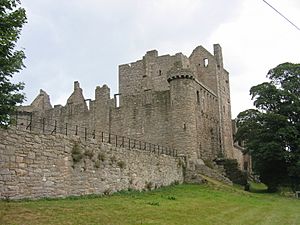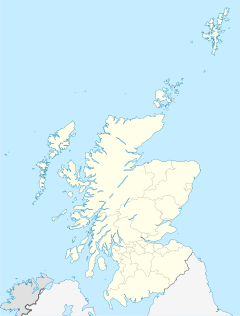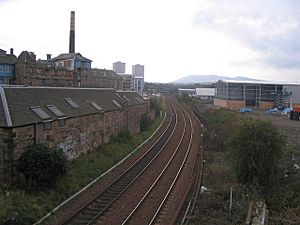Craigmillar facts for kids
Quick facts for kids Craigmillar
|
|
|---|---|
 Craigmillar Castle |
|
| OS grid reference | NT288713 |
| Council area | |
| Country | Scotland |
| Sovereign state | United Kingdom |
| Post town | EDINBURGH |
| Postcode district | EH16 |
| Dialling code | 0131 |
| Ambulance | Scottish |
| EU Parliament | Scotland |
| UK Parliament |
|
| Scottish Parliament |
|
Craigmillar is a part of Edinburgh, Scotland. It is about 3 miles (5 km) south-east of the city centre. The name comes from a Gaelic phrase meaning 'High Bare Rock'.
Contents
History of Craigmillar
Even though most buildings in Craigmillar are quite new, the area itself is very old. It is home to Craigmillar Castle, which was started in the late 1300s or early 1400s. People lived in the castle until the early 1700s. In 1660, Sir John Gilmour bought the Craigmillar estate.
In the 1920s, new homes were built in areas like Niddrie Mains. These were part of a plan to create more public housing. The Craigmillar estate, near the castle, was planned in 1936. For many years, the area had mostly homes built between the 1920s and after World War II. These included private bungalows and tall apartment blocks owned by the city council.
Today, the City of Edinburgh Council is working to make Craigmillar even better. Many older buildings have been taken down. New projects are helping to improve the area for everyone.
Breweries in Craigmillar
In the late 1800s and early 1900s, seven breweries were built in Craigmillar. This area was open countryside back then. The breweries were near the railway line. They used the excellent local water for making drinks. The first brewery, William Murray & Co. Ltd, opened in 1886. Other breweries followed, like Andrew Drybrough's and Robert Deuchar Ltd. Most of these breweries stopped making drinks in the 1960s. Drybrough's was the last to close in 1987.
Facilities and Community
In the 1980s, people in Craigmillar strongly protested about not having enough local services. Thanks to community efforts, a library and an Arts Centre were created. One important group was the Craigmillar Festival Society. This group was active from 1962 to 2002. It helped organize many community events.
The area also had a large concrete play sculpture. It was called Gulliver, The Gentle Giant that cares and shares. Artist Jimmy Boyle created it for the Craigmillar Festival in 1976. It was taken down in 2011. The University of Edinburgh has sports fields here. These include one of Scotland's oldest fields for the sport of shinty. Gulliver was also seen as a geoglyph, which is a large design on the ground.
Making Craigmillar Better
There is a big plan to improve parts of Craigmillar. It is called the "Green Quarter Plan." This plan aims to create new parks and wooded areas in Craigmillar. The Parc life development company is leading this project. They also plan to build 3,200 affordable homes. The plan includes better learning and fun places for young people.
One important old building that was kept is "The White House." This former pub is an Art Deco building. It was fixed up in 2011 and now has a gallery inside.
Population and Background
Here is a look at the different backgrounds of people living in Craigmillar compared to Edinburgh as a whole:
| Craigmillar compared | Craigmillar | Edinburgh |
|---|---|---|
| White | 92.6% | 91.7% |
| Asian | 4.8% | 5.5% |
| Black | 1.4% | 1.2% |
| Mixed | 0.7% | 0.9% |
| Other | 0.5% | 0.8% |
Getting Around Craigmillar
Craigmillar has several Lothian Buses services. Bus 42 goes from Portobello to Davidsons Mains. Bus 2 runs from The Jewel to The Gyle Shopping Centre. Bus 14 goes from Greendykes to Muirhouse. Bus 21 connects The Royal Infirmary of Edinburgh to The Gyle Shopping Centre. Bus 30 travels from Musselburgh to Clovenstone.
Craigmillar once had a local train station called Duddingston & Craigmillar railway station. It was on the Edinburgh Suburban and Southside Junction Railway line. The station closed in 1962. Some local groups want the train line to open again. They hoped it could be part of the Edinburgh Tram Network. However, this idea was turned down in 2009 because it would cost too much money.




